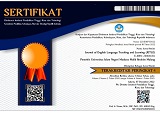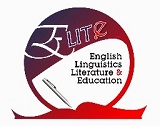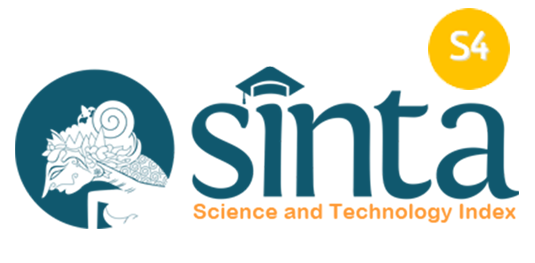Online reading strategies to boost the students’ motivation
Abstract
Keywords
Full Text:
PDFReferences
Adedoyin, O. B., & Soykan, E. (2020). COVID-19 pandemic and online learning: the challenges and opportunities. Interactive Learning Environments, 1–13. https://doi.org/10.1080/10494820.2020.1813180
Ahmadi, M. R.. (2017). The impact of motivation on reading comprehension. International Journal of Research in English Education, 2(1), 1–7. https://doi.org/10.18869/acadpub.ijree.2.1.1
Antoni, N. (2010). Exploring efl teachers’ strategies in teaching reading comprehension. Jurnal Penelitian Pendidikan, 11(2), 39–51. http://jurnal.upi.edu/file/5-Nurman_Antoni.pdf
Arian, J. (2020). an analysis of the teacher strategy in teaching reading (a descriptive study at first grade students of SMAN 12 Banda Aceh. Thesis: STKIP Bina Bangsa Getsempena Banda Aceh
Autio, O., Hietanoro, J., & Ruismäki, H. (2011). Taking part in technology education: elements in students' motivation. International Journal of Technology & DesignEducation, 21(3), 349-361. doi:10.1007/s10798-010-9124-6
Baber, H. (2020). Determinants of students’ perceived learning outcome and satisfaction in online learning during the pandemic of COVID-19. Journal of Education and E-Learning Research, 7(3), 285–292. https://doi.org/10.20448/Journal.509.2020.73.285.292
Chinappi, G. M. (2015). How to increase reading motivation among elementary children based on teachers’ perspectives and teaching methods. Education and Human Development Master’s Theses, 586, 113.
http://digitalcommons.brockport.edu/ehd_theses/586
Considine, D., Horton, J., & Moorman, G. (2009). Teaching and reading the millennial generation through media literacy. Journal of Adolescent & Adult , 52(6), 471-481. doi: 10.1598/JAAL.52.6.2
De la Orden, C., Palomo, J.& Figueroa, C. (2017). Improving learning by motivating studentsto read the news using ICT. Global Journal of Business, Economics and Management: Current Issues. 7(1), 89-98.
Dhanapala, K. V., & Hirakawa, Y. (2016). L2 reading motivation among Sri Lanka University students. Reading Psychology, 37(2), 202–229. https://doi.org/10.1080/02702711.2015.1025163
Doo, M., Bonk, C. & Heo, H. (2020). A meta-analysis of scaffolding effects in online learning in higher education. International Review of Research in Open and Distributed Learning, 21(3), 60–80. https://doi.org/10.19173/irrodl.v21i3.4638
Dörnyei, Z. (2000). Motivation in action: Towards a process-oriented conceptualization of student motivation. British Journal of Educational Psychology, 70(4), 519–538. https://doi.org/10.1348/000709900158281.
Guthrie, J. T., Wigfield, A., & Vonsecker, C. (2000). Motivation in reading. Journal of Educational Psychology, 92(2), 331–341. http://bu.umc.edu.dz/theses/anglais/GRI1048.PDF
Ikhsanudin, I., & Lestari, R. (2023). Challenges and creativities in encouraging students to read in English language lessons: In-depth interview with junior high school teachers. Journal of English Language Teaching and Learning (JETLE), 5(1), Article 1. https://doi.org/10.18860/jetle.v5i1.24157
Jahan Khan, T., Murad Sani, A., & Shaikh-Abdullah, S. (2017). motivation to read in a second language: A review of literature. International Journal of English Education,2(4),41–50. https://doi.org/10.29252/ijree.2.4.41
Klæboe, H. A. (2020). Reading motivation in Norwegian as a second language. Master Thesis. University of Oslo.
Komiyama, R. (2013). Factors underlying second language reading motivation of adult EAP students. Reading in a Foreign Language, 25(2), 149–169.
Kurniawan, N. A. (2017). Teaching strategies use in reading comprehension class at the tenth grade students of Smk Islam Sudirman 2 Ambarawa. Thesis. IAIN Salatiga..
Maican, M. A., & Cocoradă, E. (2021). Online foreign language learning in higher education and its correlates during the COVID-19 pandemic. Sustainability(Switzerland), 13(2), 1–21.https://doi.org/10.3390/su13020781
Niazi, T., & Zahid, M. (2019). Intrinsic and extrinsic motivation for learning English as a Second Language ( ESL ) among pre- university students of Pakistan. International Journal of Research and Innovation in Social Science (IJRISS) |Volume, III(Xi), 135–139. www.rsisinternational.org.
Pachtman, A. B., & Wilson, K. A. (2006). What do the kids think?. The Reading Teacher, 59(7), 680–684. https://doi.org/10.1598/rt.59.7.6
Pang, E. S., Muaka, A., Bernhards, E. B., & Kamil, M. L. (2013). Teaching reading. In International Academy of Education (Vol. 18). https://doi.org/10.1017/s0267190500003512
Pangestika, A. M. B. (2018). A small-scale survey on reading motivation of undergraduate students.Thesis. Islamic University of Indonesia.
Protacio, M. S. (2012). Reading motivation: A focus on English learners. Reading Teacher, 66(1), 69–77. https://doi.org/10.1002/TRTR.01092
Putera, A. A., Anggrainy, F. P. N., & Istifadah, I. (2023). Teachers’involvement and recognition for influencing EFL students’reading motivation in online learning context: A qualitative case study. Lingua Scientia, 30(2). https://ejournal.undiksha.ac.id/index.php/JJBI/article/view/66756
Ranggi, (2019). Teacher strategies in teaching reading comprehension at the third grade of state junior high school 23 Jambi. Thesis. State Islamic University Sulthan Thaha Saifuddin.
Risinger, A. (2013). Aggie digital collections and scholarship teacher reading motivation practices. Thesis. North Carolina Agricultural and Technical State University.
Rohmana, W. I. M., & Amalia, K. R. (2022, December). Exploring the use of narrative text in teaching reading comprehension in EFL classroom. In Proceeding of International Conference on Islamic Education (ICIED) (pp. 488-496).
Ryan, R. M., & Deci, E. L. (2000). Intrinsic and extrinsic motivations: Classic definitions and new directions. Contemporary Educational Psychology, 25(1), 54–67. https://doi.org/10.1006/ceps.1999.1020
Salikin, H., Bin-tahir, S. Z., Kusumaningputri, R., & Yuliandari, D. P. (2017). The Indonesian EFL students’ motivation in reading. https://doi.org/10.5539/elt.v10n5p
Troike, M. S. (2006). Introducing second language acquisition. Cambridge University Press. www.cambridge.org/9780521790864
Unrau, N., Ragusa, G., & Bowers, E. (2015). Teachers focus on motivation for reading: “It’s’s all about knowing the relationship.” Reading Psychology, 36(2), 105–144. https://doi.org/10.1080/02702711.2013.836582
Wigfield, A., Guthrie, J. T., & McGough, K. (1996). A Questionnaire measure of children’s motivations for reading. Instructional Resource No. 22. National Reading Research Center, Spring 1996, 1–24.
http://files.eric.ed.gov/fulltext/ED394137.pdf
Wu, L., Valcke, M., & Keer, H. Van. (2021). Supporting struggling readers at secondary school : an intervention of reading strategy instruction. Reading and Writing, 0123456789. https://doi.org/10.1007/s11145-021-10144-7
Yulita, D., & Neno, H. (2021). Do teachers fond of reading ? teachers ’ affective states in EFL reading. Journal of English Language Studies 6(1), 52–64.
Zhao, B. (2016). Motivation, identity, and l2 reading : Perceptions of Chinese ESL students in Canada. Electronic Thesis and Dissertation Repository, November.https://ir.lib.uwo.ca/cgi/viewcontent.cgi?article=5867&context
DOI: https://doi.org/10.18860/jetle.v5i2.26522
Refbacks
- There are currently no refbacks.
Jalan Gajayana 50 Malang 65144, Jawa Timur, Indonesia

This work is licensed under a Creative Commons Attribution-ShareAlike 4.0 International License.
Indexed by





